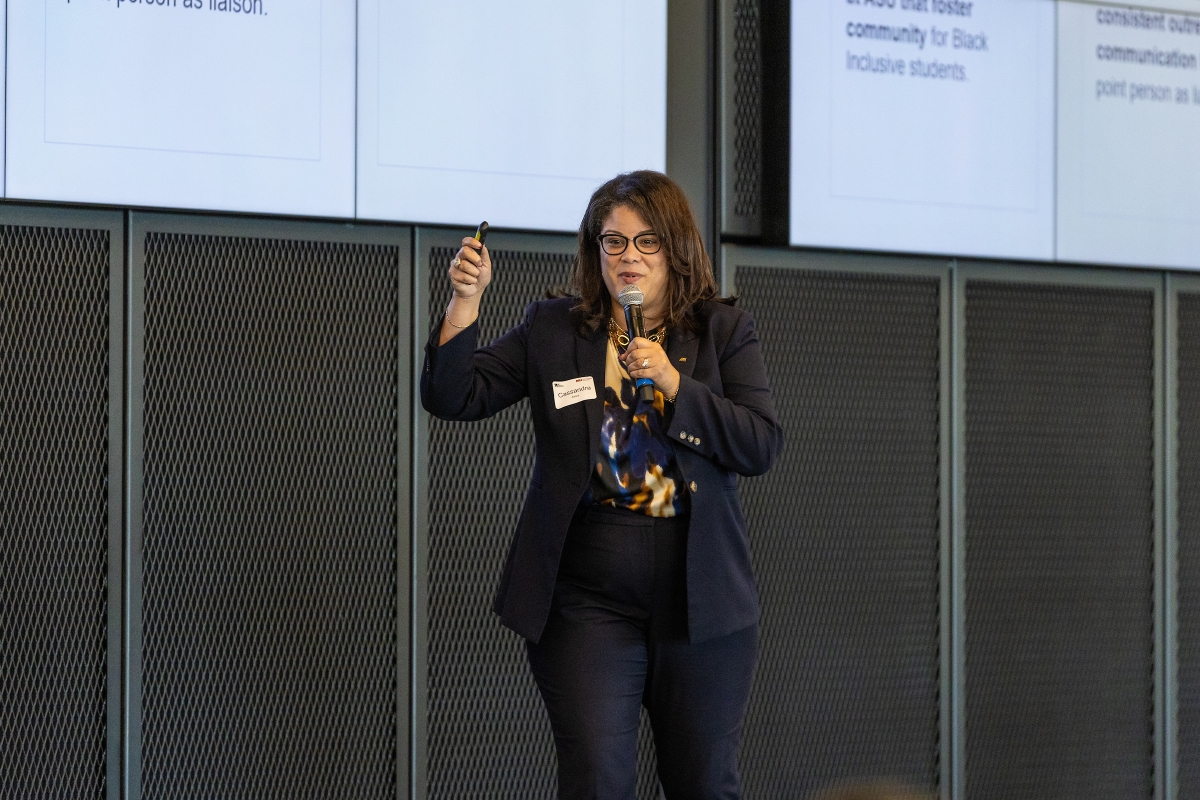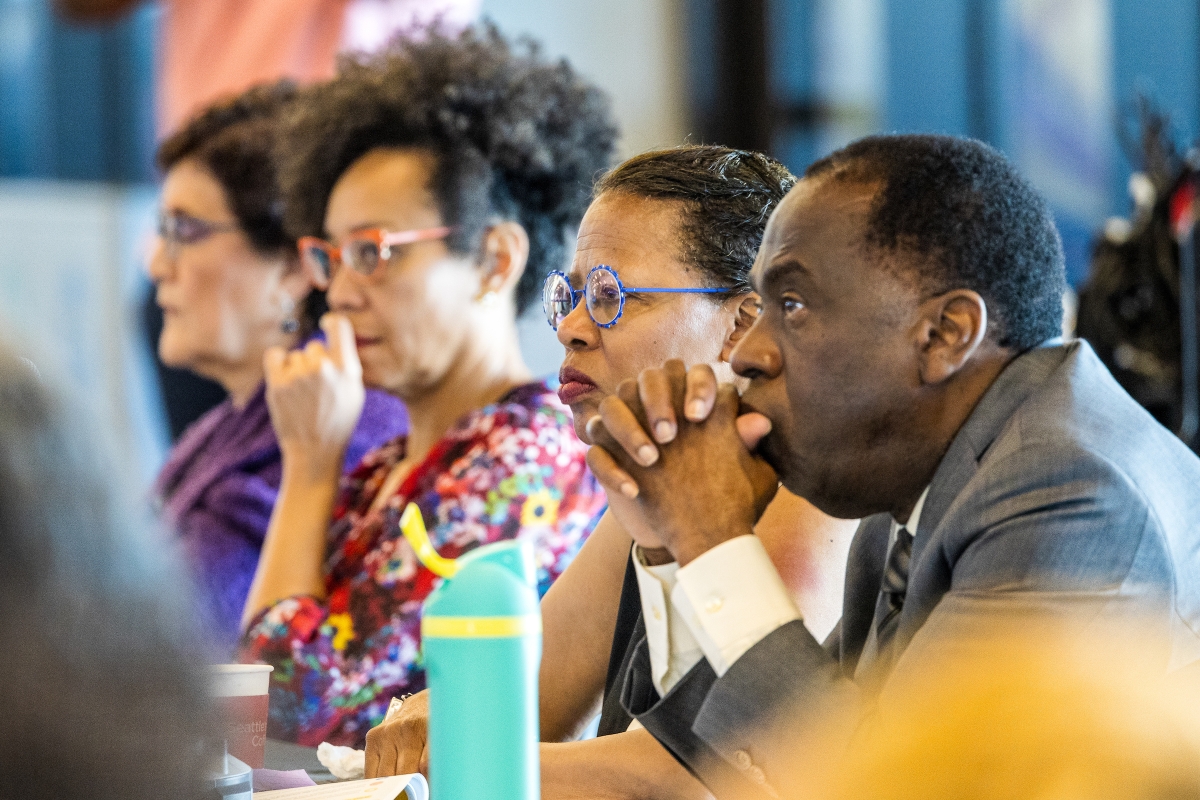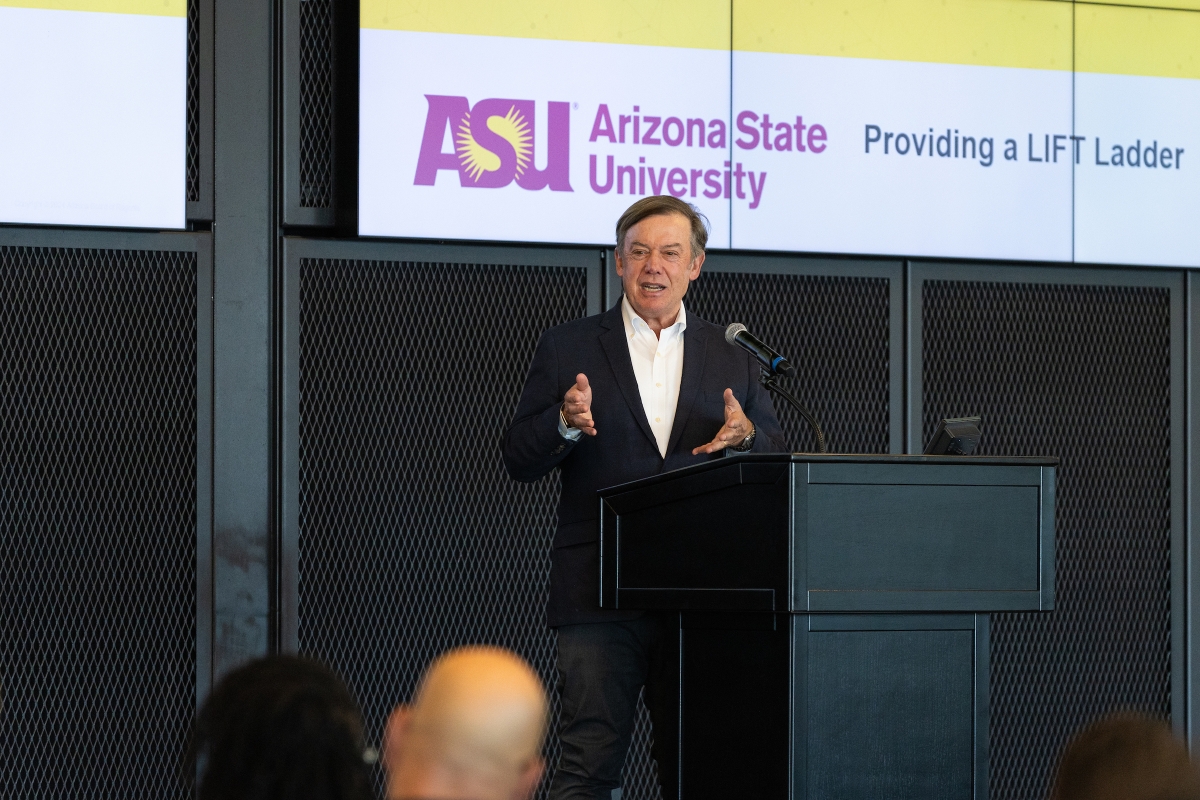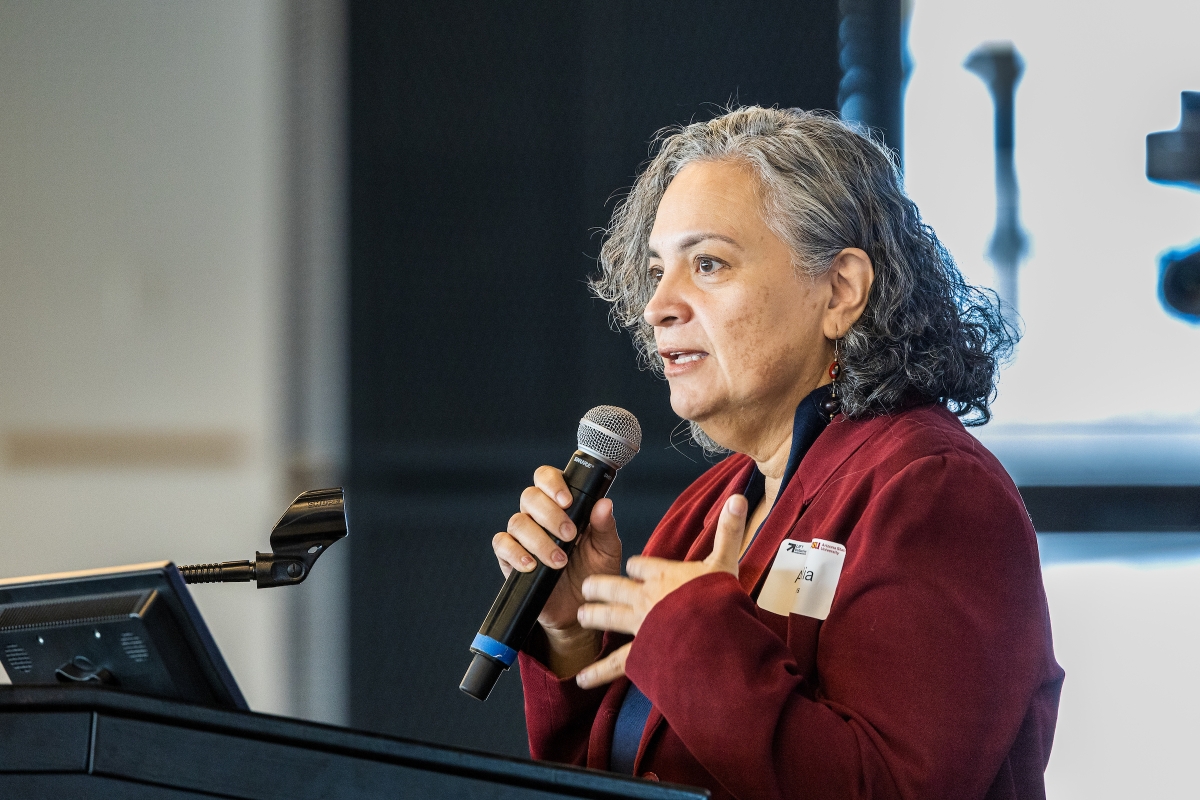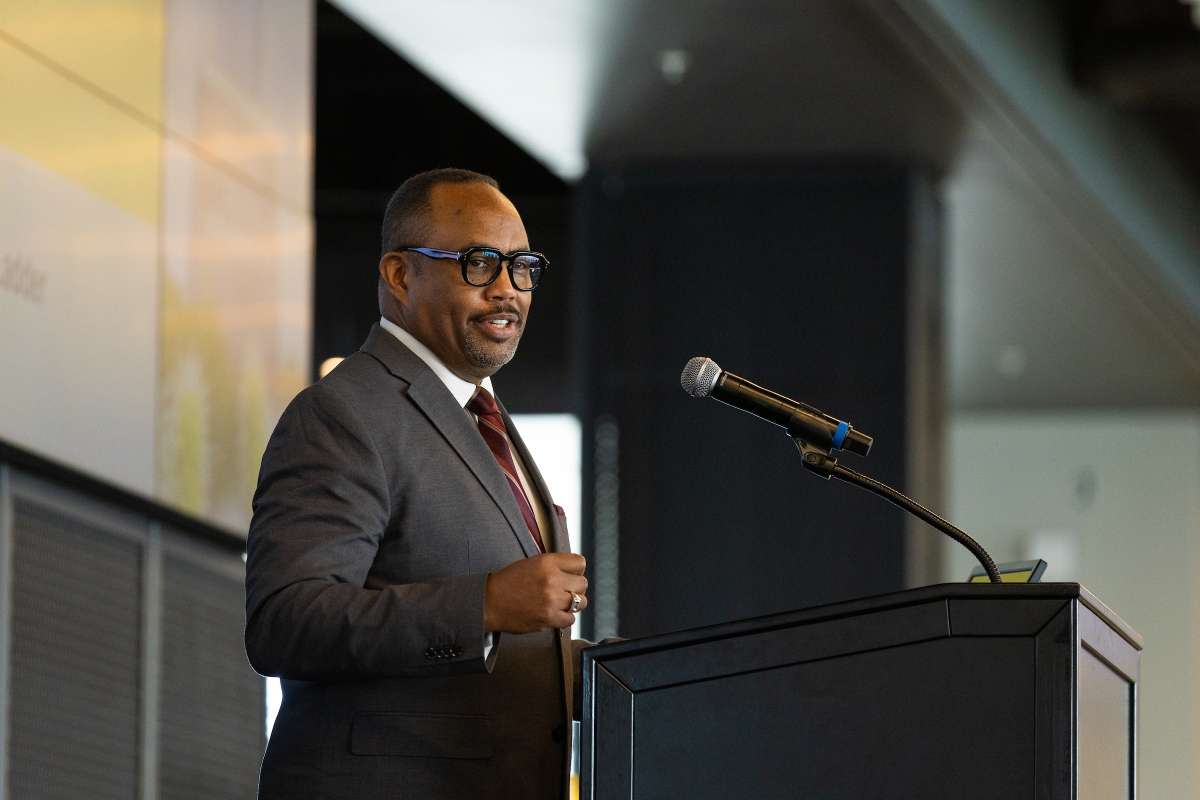Annual LIFT Summit highlights how support for Black students is embedded at ASU

Chris Howard, executive vice president and chief operating officer of ASU, addressed the third annual LIFT Summit at the San Tan Ford Club in Mountain America Stadium on Tuesday, Sept. 3. Photo by Charlie Leight/ASU News
While Arizona State University has made great progress on the initiative launched in 2020 to support the success of Black students, faculty and staff, the university is now working on incorporating the changes into the culture.
Several dozen ASU faculty, staff members and students gathered on Tuesday, Sept. 3, to hear about the evolution of the LIFT Initiative — for Listen, Invest, Facilitate, Teach. The LIFT Initiative was created by ASU President Michael Crow in 2020 to create meaningful change at the university and contribute to a national agenda for social justice, in response to feedback from ASU’s students, faculty and staff.
The third annual LIFT Summit was titled “Providing a LIFT Ladder.”
“We are constantly thinking, ‘How does this become part of what we do every single day at ASU?’" said Colleen Jennings-Roggensack, vice president of cultural affairs at ASU.
“It’s not a special thing. It’s not an initiative. It’s something we do all the time.”
Jennings-Roggensack is co-chair of the Advisory Council on African American Affairs along with Jeffrey Wilson, associate dean of research and inclusive excellence in the W. P. Carey School of Business.
Tuesday’s LIFT Summit covered progress on the action goals, such as increased hiring of postdocs from all underrepresented groups to create a faculty pipeline, but also used storytelling to highlight successes. Among the ways that the LIFT Initiative have advanced over the past three years are:
Constellation hiring: Amalia Pallares, vice provost for inclusive excellence, described this method of recruiting faculty members of color this way: “There is a senior star hired who is incredibly accomplished and talented and recognized, and then this person would be able to recruit. It’s envisioned that they would support and mentor each other and bring a line of research that is of international importance that would attract incredible people.”
In Pallares’ example, the Department of English star hire was Ayanna Thompson, Regents Professor, executive director of the Arizona Center for Medieval and Renaissance Studies at ASU and a world-renowned scholar of Shakespeare. Thompson then recruited Ruben Espinosa, director of the Arizona Center for Medieval and Renaissance Studies; Madeline Sayet, clinical associate professor and stage director, writer and performer; Lisa Barksdale-Shaw, an assistant professor who studies literature and the law; and Brandi Adams, an assistant professor who researches premodern critical race and gender studies.
Another example is Natalie Diaz, a professor of English who won the 2021 Pulitzer Prize in poetry. She recruited the writer Mitchell Jackson, the 2021 Pulitzer Prize winner for feature writing, and Safiya Sinclair, an author and poet who won a Guggenheim Fellowship this year.
Relationships with HBCUs: ASU has been forging partnerships with several historically Black colleges and universities. Chris Howard, executive vice president and chief operating office of ASU, gave some examples, such as the Immersive Storytelling Project, hosted in June by The Sidney Poitier New American Film School. The weeklong event included students from ASU and Morehouse College, Spelman College and Clark Atlanta University, three historically Black schools in Atlanta. The group met industry experts and got hands-on experience with extended-reality technology at the ASU Media and Immersive eXperience Center in Mesa.
Another example is an agreement to offer real-estate development courses in the W. P. Carey School of Business at ASU to students at Grambling State University in Louisiana. The program, which is meant to increase diversity in the real estate field, was facilitated by Murphy Cheatham, an alum of Grambling who earned a Master of Real Estate Development from ASU in 2007.
“We’re taking a wonderful asset that’s serving our students well and saying, ‘We’ll take responsibility for the communities we serve and lift up Black people,’” said Howard, who is leading a working group at ASU to partner with HBCUs.
Peer support: Last spring, the Graduate College launched a program called Community Advocates, in which more advanced graduate students become peer mentors for Black students who are first-year graduate students. The college hired 20 community advocates, who will be paid $2,500 a semester and meet every other week at each metro campus and ASU Online.
“The idea is that they can be available to help new scholars navigate ASU specifically but also the culture of higher education, and hopefully influence and change the culture of higher education where it’s needed,” said Elizabeth Wentz, dean of the Graduate College.
Community connections: The LIFT Initiative has led to strengthened bonds with community partners, according to Kenja Hassan, assistant vice president for government and community engagement.
“One of the most valuable things about being employed at ASU in the era of Michael Crow is the idea of the charter and the idea that we would be stewards and shepherds of our community,” Hassan said, noting that many ASU faculty and staff are already active in the community.
For example, over the past four years, Educational Outreach and Student Services at ASU has partnered with the Greater Phoenix Urban League Young Professionals on a leadership and mentoring program called YP CoNext that matches Black ASU students with professionals who are 40 or younger.
“Young professionals want to give back. We didn’t have this mentorship growing up,” said Ashlee Atkins, culture and inclusion manager at ASU Enterprise Partners and the immediate past president of the Greater Phoenix Urban League Young Professionals.
“It’s a one-on-one partnership so they can see representation within the fields of their choice or interest areas. We have monthly sessions showing representation in areas such as ‘Being Black in HR,’ ‘Being Black in Tech’ and ‘Being Black in Finance,’” she said.
Awareness and communication: To embed support for Black students, everyone who works at the university should be aware of the resources available, according to Cassandra Aska, deputy vice president for student services and co-chair of the Black Student Success Initiative.
“What students shared with us is that when they’re connecting with a faculty or staff person who does not understand what the Black student experience is at ASU, it has an impact on their sense of belonging at the university,” Aska said.
She said that lack of awareness about resources can lead to the assumption that they’re not available.
She listed just a few of the many resources for Black students, including the Sankofa Leadership Institute, the Black Excellence Experience Tour, the RISE Summer Leadership Institute, the Black African Coalition and the Black African Convocation.
“The second thing is communication. Our students said to us, ‘We don’t know what’s going on, and we don’t know what the opportunities are and everything is engulfed in all of ASU,'” Aska said.
“We have a summer campaign, and we highlight the Black student experience in preparation for them to come here. This goes to all new Black students, undergraduates and graduates,” she said.
Her team also partnered with the academic colleges to send letters to incoming Black students highlighting student organizations, Black faculty and staff, and introducing a contact person, who doesn’t have to be Black.
“The students told us ‘There’s value in having someone who looks like me, but also there’s a lot of value in someone who takes the time to respond to me,’” she said.
Crow addressed the group, describing how inspired he was by the 2021 book “The Sum of Us: What Racism Costs Everyone and How We Can Prosper Together” by Heather McGhee.
“My skin was crawling. I was both mad at her and mad at me and mad at everybody because she was just telling the truth,” he said.
“And the truth was very painful.”
Crow said that ASU has become “a ‘sum of us’ university.”
“We’ve become a university that’s built on the notion of driving up the sum of us by lowering these barriers to entry and overcoming to every extent we can all these forms of racially based barriers,” he said.
But there’s more to be done.
“We are still looking for more ways to follow the golden rule in the way we run this institution.
“No one will be left out for any reason, because the sum of us is too important.”
More Sun Devil community

ASU wide receiver Xavier Guillory driven by faith, family and heritage
It’s a few minutes into the Zoom call when Arizona State senior wide receiver Xavier Guillory is asked about his father.He looks up and keeps his gaze there, as if he’s picturing his father, Raphael…

Our photographers share their favorite photos of 2024
Photos can tell a story in ways that words sometimes can't, capturing the action, beauty and emotion of the moment. And as we look back at our top stories from 2024, we asked our ASU News…

How Kenny Dillingham remade ASU's football team in just 1 year
When Arizona State University football coach Kenny Dillingham went about rebuilding his roster after a 3-9 season in 2023, the most difficult thing he had to do was say no.Dillingham knew the Sun…
